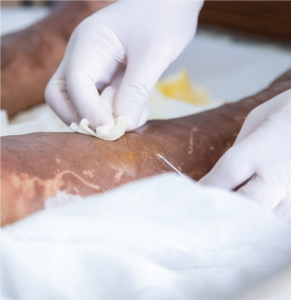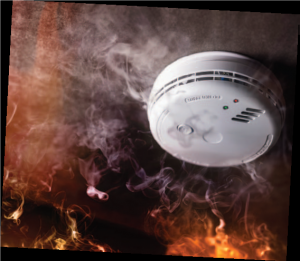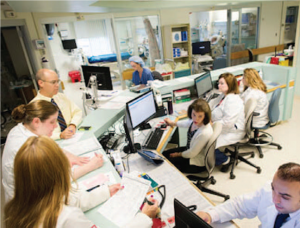The Cooperman Barnabas Burn Center team makes the state’s toughest cases its business.
RWJBarnabas Health
The relationship between humans and fire is an old and complicated one. Controlling fire and fearing it are both baked into our DNA. Few thoughts are more terrifying than the prospect of being trapped by flames; the pain generated by a severe burn is unimaginable to all but the unfortunate few who have experienced it. How firefighters and people who work near intense heat do what they do is incomprehensible to most of us. That being said, roughly 1 in 700 Americans will have to be admitted to an emergency room to treat a burn injury in 2023. One in 10 of them will be admitted to the hospital—often with life-threatening third- or fourth-degree burns.
In New Jersey, the most severe cases end up in the hands of the doctors and medical staff at the Cooperman Barnabas Burn Center in Livingston—New Jersey’s only state-certified burn treatment center. The Burn Center has 12 beds in its intensive care unit and another 18 beds for non-ICU cases. As three-quarters of serious burns are accidental, there is no “typical” patient at the Cooperman Barnabas Burn Center. Which is why the facility is ready and able to treat anyone from an infant to a geriatric admission.
About 400 to 500 patients are treated annually at the Burn Center, which is recognized by the American Burn Association and American College of Surgeons for the optimal care provided by the dedicated team of multidisciplinary medical professionals. The team is headed by two accomplished surgeons: Medical Director Michael Marano, MD, and Associate Medical Director Robin Lee, MD.
The Burn Center has been in operation for 45 years, but it gained national attention in 2008 with the publication of Pulitzer-nominated After the Fire: A True Story of Friendship and Survival by Robin Gaby Fisher. The book chronicled the recovery of two teenage students who were badly burned in the deadly fire that swept through a freshman dorm at Seton Hall in 2000. Their cases still rank as two of the worst the Cooperman Burn Center had ever treated.

www.istockphoto.com
Aftercare
The increased survival rate of badly burned people has brought about a new set of issues that are being addressed at Cooperman Barnabas and other burn units around the country. Once wounds have healed and a patient is out of physical danger, for many the work has just begun.
The anxiety and depression that frequently accompanies physical recovery can lead to crippling PTSD and feelings of low self-esteem and social isolation that come as a result of visible disfigurement (especially to the head, face and neck).
Studies have shown that non-resolution of these issues can lead to chronic psychiatric problems; one study conducted through the National Institutes of Health in 2017 reported that 100% of burn victims experienced significant anxiety during their recovery and a “vast majority” demonstrated depressive symptoms. The study underscored the importance of sensitizing burn-ward staff members to the psychological needs of their patients.
Understanding Severity

www.istockphoto.com
Have you ever wondered, when reading that someone has suffered burns over, say, 20% of his or her body, how that number is determined? There is actually a chart that assigns numbers to different areas of the body for adults, obese adults, children and infants.
Doctors note the affected regions and start adding up the numbers. The anterior and posterior torso take up the most real estate—18% each in adults and 24% each in obese individuals.
Burn severity is measured in “degrees”—from first-degree to fourth. First-degree burns are superficial and the least serious. They can be caused by any heat source, including the sun. Though painful, they only affect the outer layer of skin (the epidermis). Second-degree burns involve the lower layer of skin (the dermis) and often cause blistering or swelling.
Third-degree burns reach deep down to subcutaneous tissue and destroy the epidermis and dermis, leaving charred or white skin. Fourth-degree burns are obviously the worse. They can affect muscle and bone and destroy the nerve endings in the burn area. Third-degree and above are considered “severe” and potentially life-threatening burns; often they call for skin grafts—one of the specialties of the Cooperman Barnabas Burn Center surgeons.
According to the American Burn Association, severe burns are credited with taking 3,400 lives in the US each year, with residential fires accounting for about 75% of fatalities. Inside that number, the ABA does not distinguish between deaths from burning and smoke inhalation. Vehicle fires, usually caused by a crash, claim around 300 lives a year. The remaining 500-plus burn deaths include everything from scalding to electrical burns to people who perish in wildfires.

www.istockphoto.com
Fear of Fire
The very natural and healthy human fear of being burned is different from pyrophobia, a debilitating fear of fire. Pyrophobia sufferers experience severe stress or panic attacks at the sight of a small flame or even the smell of something burning. They have been known to get dizzy at backyard barbecues and can become anxious when they overhear others talking about a fire.
Only a very small percentage of individuals suffering from pyrophobia have had a life-threatening or even dangerous experience with fire. Like many people who suffer from phobias, they acknowledge their fear is untenable, but that doesn’t make it any easier to overcome. Some studies suggest that pyrophobia runs in families—either it is learned or inherited. The most effective treatment strategy involves exposure therapy or cognitive behavioral therapy, or sometimes both.
Physical Response

www.istockphoto.com
The human body is capable of miraculous feats of healing. However, it is not built to respond to severe burns. Burn injuries trigger the body’s inflammatory response—the reaction that fights off “invaders” ranging from viruses and bacteria to toxins and cancer cells. In the case of a deep or extensive burn, the inflammatory response can trigger a sudden drop in blood pressure, sending a victim into shock. It can also trap fluid inside the body. In either case, if vital organs (heart, lungs, kidneys, brain) do not receive the oxygen they need, they can go into failure and a burn victim Even when a burn patient is stabilized, the damage done to the skin—which is the body’s first line of defense against bacteria—can lead to infection and sepsis at a time when the immune system has been significantly compromised. A generation ago, the outlook for patients suffering burns over more than 50% of their body was bleak. Now it is not unheard of for people with burns covering 80% or more to pull through. Much of the progress can be credited to the myriad ways skin grafts are done, as well as a better understanding of the healing process for third- and can die. fourth-degree burn victims—including the roles played by nutrition, pain management, wound treatment and the battle against infection.
Of course, preventing burns and increasing awareness of how and when they are most likely to occur, are significant parts of keeping the public safe. To that end, the Cooperman Barnabas Burn Foundation supports a wide range of educational programs aimed at different constituencies, ranging from firefighters to healthcare professionals to schoolchildren.
Editor’s Note: The Cooperman Barnabas Burn Center is located at 94 Old Short Hills Road in Livingston. Like Trinitas Regional Medical Center, it is part of the RWJBarnabas Health System. The Burn Center offers a Firefighter Health & Safety Education course, a Standard Operating Guide, free lung cancer screenings and other resources to give firefighters the resources they need to manage their health.








